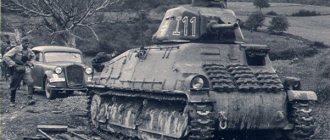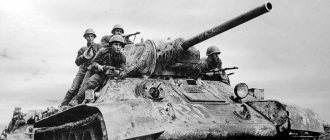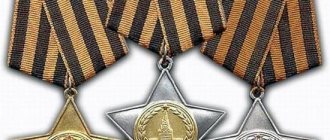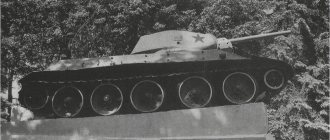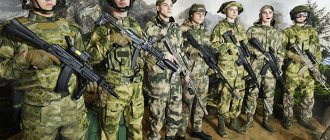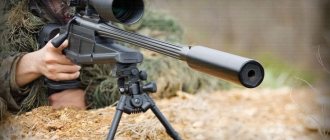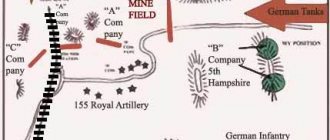Author: Fima Petrov
January 16, 2022 01:05
Community: Military
Tags: USSR wars history facts
116463
21
When, in the morning hours of June 22, 1941, the German army began implementing Plan Barbarossa - an attack on the Soviet Union - Soviet troops were taken by surprise (not all, of course, but the majority).
0
See all photos in the gallery
And, although the Red Army was armed with a large number of types of armored vehicles that were completely unknown to the Germans, nevertheless, this technical superiority could not compensate for the catastrophic tactical mistakes of the army command. An unexpected fact for the Wehrmacht was not only the large number of Soviet tanks that the German troops had to face, but also their high combat qualities, especially the latest tank designs.
0
Although produced in limited quantities, literally in the last months before the German attack, the new types of Soviet tanks - T-34 and KV - were a very serious opponent. Even before the start of Operation Barbarossa, their number and combat characteristics, and in some cases even their very existence, were not discovered by German military intelligence services.
×
0
The fact that the new Soviet tanks, including the KV-2, turned out to be a surprise for the German command is evidenced, for example, by an entry in the diary of Colonel General Franz Halder, who wrote on June 24, 1941: “At the front of Army Group North.” “new Russian heavy tanks have appeared, which are most likely armed with an 80 mm caliber gun, or even a 150 mm caliber gun, which, however, is unlikely.” But the very next day, when new updated reports arrived, Halder was forced to agree with reality. He wrote: “Scattered information is being received about new Russian tanks: weight 52 tons, forehead armor 37 cm (?), sides 8 cm, armament 152 mm cannon and three machine guns, crew 5 people, speed 30 km/h, power reserve 100 km. Fighting capabilities: 50 mm cannons penetrate armor under the turret, 88 mm cannons probably also penetrate side armor (unknown for sure).”
0
An excellent example of such complete ignorance is the conversation that took place in early August 1941 between Adolf Hitler and the commander of Panzergruppe 2, General Guderian: Hitler: “If I had known that the data on the number of Russian tanks given in your book (Guderian “Achtung Panzer ", 1937) were correct, then I think that I (perhaps) would never have started this war."
0
Guderian in his book estimated the number of Soviet tanks at 10,000, which caused a sharp reaction from German censors. However, it turned out that Guderian's estimates were even too low. On August 6, 1941, the command of the German army officially announced that the total number of destroyed Soviet tanks was 13,145. This figure seems to correspond to reality, given that between 1933 and 1941 the USSR built more than 30,000 armored vehicles of all types (including armored cars). Approximately 20,000 of this number were light tanks, while the number of heavy tanks was only 1,800, including the latest types. This number seems relatively small compared to the production of tanks in the USSR (for example, T-26 light tanks), but compared to the tank fleet of other European armies it is quite significant.
0
***KV-2 produced in May - June 1941 from the 1st Mechanized Corps of the North-Western Front got stuck on July 4, 1941 near the village of Gubari, Pytalovsky District, Pskov Region. It went to the Germans.***
0
Quite recent Russian sources provide the following data on the composition of the Red Army on June 1, 1941: personnel - 5,224,066; field artillery - 48,647; mortars - 53,117; anti-aircraft guns - 8,680; tanks and other armored vehicles - 25,932; trucks - 193,218; tractors and tractors - 42,931; horses - 498,493. But by July 15, 1941, only about 1,500 tanks remained combat-ready. ***KV-2 produced in November - December 1940 from the 12th Tank Division of the Southwestern Front. The inscription on the tank's turret is “2/Rgt. Goring. 29.6.41" - indicates that this KV-2 was shot down by anti-aircraft gunners of the 2nd battalion of the anti-aircraft regiment "General Goering" in the Dubno area (therefore, they were only able to hit 8.8 cm).***
0
The German High Command quickly realized the danger of the situation. The fight against the new T-34 and KB tanks required enormous effort and led to heavy losses. Therefore, just a month after the start of hostilities, the army information leaflet “D 343 Merkblatt fur die Bekampfung der russischen Panzerkampfwagen” was issued to instruct German soldiers on methods of fighting Soviet tanks. We can say that it was a symbol of shock from the collision with the T-34 and KV. By the way, it is interesting that when faced with the KV-2 tanks, the Germans initially believed that the KV-2 tank of the 1939 model was a later version of the vehicle, and accordingly assigned it the index KW-IIB, i.e. an improved version compared to the KV-2 of the 1940 model, which received the KW-IIA index. ***KV-2 produced in November - December 1940 from the 8th Tank Division of the 4th Mechanized Corps of the Southwestern Front. Nearby is KV-2 No. 9. These tanks were left in the city of Zhovkva, Lviv region.***
0
Despite the fact that most KV-2 tanks were lost not in battle, but due to mechanical failures, as a result of which they had to be abandoned due to the impossibility of repair and restoration, the German offensive was significantly slowed down. Sometimes only one single KV-2, occupying a key position on the front line and supported by infantry, was able to stop the enemy advance. The powerful armor of this tank and the weakness of German anti-tank weapons of that time made it possible to delay even large units for many hours or even days. Some KV-2s withstood up to 20 direct hits before being destroyed by 88 mm anti-aircraft guns acting as anti-tank guns or calling in Ju-87 Stuka dive bombers to attack. ***This KV-2, produced in May - June 1941, from the 14th Tank Division of the 7th Mechanized Corps of the Western Front was lost in July 1941 in Vitebsk. The picture shows the domes of the St. Nicholas Cathedral in the city of Vitebsk. Most likely, the picture shows a KV-2 (serial number B-4697), which: “...and when she was returning, after the brakes failed on the climb after the bridge over the Western Dvina River, she fell down a slope and 10.7.41. was blown up" (from the report).***
0
Another way to fight the Russischer Koloss was to attack with infantry and conduct close combat, which usually involved heavy losses. Heavy field artillery could also play a role in solving the “KV-2 Problem.” However, only 10 cm Kanone 18, lFH 10.5 cm and sFH 15 cm had a limited number of anti-tank shells in their ammunition for direct fire. Other field guns had to rely mostly on luck in trying to achieve a direct hit when firing the KV-2 along ballistic trajectories. ***Comparison photo: KV-2 and T-26***
0
The main German tanks of that period, which were at the forefront of the offensive, were rarely used to combat the KV-2. They were too poorly armed to effectively fight the Soviet heavy tank: the PzKpfW III had a 3.7 cm KWK gun; PzKpfW III - 5 cm KWK L/42; PzKpfW IV -7.5 cm KWK L/24; PzKpfW 38 (t) - 3.7 cm; PzKpfW 35 (t) - 3.7 cm. Despite the fact that the number of KV-2 tanks in the first months of hostilities remained relatively small and many of them were lost without effort on the part of the enemy, in the technical aspect its influence is difficult to overestimate. The consequence of the “T-34, KW Shock” for the Wehrmacht was the adoption of much better armed and armored tanks PzKpfW VI “Tiger” in 1942 and PzKpfW V “Panther” in 1943. ***Comparison photo: KV-2 and T-28***
How six soldiers and one tank held off an entire tank group
It so happens that we know about the unique battle near Raseiniai thanks to direct participants in those events, albeit from the opposite side. In 1945, high-ranking German officers were officially captured by the United States. In fact, they were used as military advisers for a future possible war with the USSR. The Americans knew something, guessed something, but one of the reports, presumably from Colonel General Franz Halder, simply shocked the US military.
On June 23, 1941, near the Lithuanian town of Raseiniai, Soviet tanks launched a counteroffensive. According to the calculations of the Red Army command, no more than twenty tanks of the Seckendorf group should have resisted them; the number of artillery and infantry was not taken into account at all. A battalion of heavy KV tanks, which the Germans had never encountered at the front, was taken from the 2nd Panzer Division. The task was simple - to attack the enemy on the flank and thereby force him to retreat to the Dubisa River. But in reality, everything turned into a tank battle, where there were about a hundred German tanks against 20 Soviet tanks.
In the early stages of the war, Germany did not have tanks capable of penetrating the 70mm KV armor. Only anti-tank guns or some types of artillery were capable of doing this. Therefore, in the first minutes of the battle, the surprise of the German soldiers knew no bounds. The shells of their Pz-35 tanks did not even leave dents on the armor of the “Stalinist monster,” but the KV’s return shots destroyed everything in their path. Only a few moments passed, and the entire field was littered with crushed German tanks, and the KV battalion was already moving through enemy infantry, its target was artillery. When most of it turned into scrap metal, thunder was heard - German anti-aircraft guns began to hit the tanks with direct fire. Under a hail of shells, having lost several vehicles, the battalion managed to retreat, leaving behind complete chaos.
The first acquaintance with “Kliment Voroshilov” did not turn out to be pleasant for the Nazis - several dozen Pz-35s, a battery of 150 mm artillery, dozens of anti-tank guns, trucks were destroyed, and infantry losses numbered in the hundreds. But the second appearance of the KV forced all German commanders to respect this machine.
A few kilometers from the tormented tank group "Seckendorf" were its colleagues - the Routh group. Things were going much better here, there were practically no losses, the city of Raseiniai was taken, and individual skirmishes with the Red Army did not bring alarm. But then one evening, June 23, a tank appeared within sight of the road to Raseiniai. Apparently, this was a modification of the KV tank - KV-2, which was equipped with a 152-mm tank howitzer, but no documentary evidence of this has survived. If it was really him, then one can only imagine what horror gripped the tankers of the light German tanks of the Routh group, who saw him early in the morning.
At first glance, the tank looked abandoned - it was a very unimportant place for an ambush. If there was anyone there, then surrounding and destroying the tank in an open field was as easy as shelling pears for the Germans. Most likely, the Soviet crew lagged behind their platoon or broke down, and therefore did not pose a threat. However, as soon as a column of German tanks and cars appeared on the road, the monster “came to life.” With his first shot, he blew up a truck with fuel, then one by one destroyed several anti-tank guns and tanks, and then again began to “click” trucks with provisions. When the highway began to resemble hell, and German tanks were hardly recognizable in the pile of metal, KV calmed down. There were several small dents and chips on its hull, but no one was able to penetrate its armor. True, after the battle the tank did not move on, but continued to stand motionless right on the road, as if it could not move.
The incident at Raseiniai alarmed the German headquarters, since this skirmish indicated an imminent advance of Soviet troops in the area of this highway, and the invulnerable KV looked like just a bait. Realizing the danger of the situation, the leadership decided to immediately throw all available tank reserves into the area. A day later, new columns of gray German tanks appeared on the road, and along with them there were 88-mm anti-aircraft guns, for which the KV’s armor was not impenetrable.
From the outside, the situation seemed absurd and wild: a whole army, and against it a lone KV, which again looked as if its crew had already abandoned it. But soon “Kliment Voroshilov” again greeted the guests with a booming explosion of shells. The 88-mm anti-aircraft gun was the first to be damaged; it was almost blown away by a 152-mm shell. The advance of the Soviet tankers was confident: a tank, another, another gun... But now the Germans realized that in front of them was not the leading tank of the Russian offensive, but just one vehicle with a desperate, but not broken, crew inside.
The minutes of our tank crews were numbered, the selfless tank was literally torn to pieces. Taking advantage of their numerical advantage, the Pz-35s calmly surrounded the lone KV, while the remaining 88-mm guns showered the tank with a hail of shells. After the thirteenth hit, the KV stopped moving. But even then the Nazis did not dare to touch the enchanted tank. Only after waiting for some time and making sure that the enemy was destroyed did the German soldiers dare to approach him. But when they approached a distance of several meters, the tank’s turret suddenly began to turn in their direction - the crew was still alive! The frightened soldiers began to run away in all directions, but several grenades thrown into the armored space of the Soviet tank completed the fate of the valiant Red Army soldiers...
The amazed Germans found the bodies of six brave tank crews in the tank. For two whole days, one tank with 6 tankers held back a tank group and several hundred infantrymen! War was war, but military exploits were always honored by both allies and enemies, so the heroic crew was buried by the Germans with military honors.
In 1965, the tankers were reburied in a military cemetery near Raseiniai, the names of three soldiers are still unknown. Personal belongings suggested the names of two fighters: Ershov P.E., Smirnov V.A. and only the initials of the third - Sh.N.A. In memory of those events, not far from the site of the legendary battle, near the village of Dainiai, there is a military memorial dedicated to the nameless Red Army soldiers.
KV-2 training models for training Wehrmacht soldiers
0
After the Wehrmacht encountered medium and heavy Soviet tanks in the first days of the Barbarossa plan, the German command took urgent measures to effectively prepare its troops to fight this new unexpected enemy. The German infantry and panzergrenadier units quickly adopted a new training program that was adequate to the current situation. Using a large number of different models to train soldiers since the early 1930s, German units also built their own wooden models of Soviet tanks on a 1:1 scale.
0
They were often extremely detailed and precisely executed. The high level and good quality of model work made it possible to create models of a combat vehicle that correspond to a real tank not only in size, but also to reproduce on it various angles of inclination of armor protection sheets, for training in the use of magnetic anti-tank mines, handrails and steps for climbing onto a tank, the location of hatches and observation devices, firing angles, not only the main weapons, but also machine guns. Training mock-ups of tanks were often mounted on four-wheeled chassis so that they could simulate their movement at the actual speed of tanks. Although most of these training models were built to imitate the Soviet T-34 medium tank, some other much less common types of armored vehicles were also reproduced. Currently, the existence of only one wooden KB-2 can be documented. ***The photograph is dated November 1943. The wooden model of the T-34 is driven by a wedge. A German soldier threw a smoke bomb, imitating a grenade throw.***
0
***Wooden T-34 and KV-2.***
Further evolution of the KV-2. Or urban battle tanks for the Red Army
Home » Alternative tank building » Further evolution of the KV-2. Or urban battle tanks for the Red Army
Editor's Choice Alternative Tank Building
boroda 09.12.2021 1730
12
in Favoritesin Favoritesfrom Favorites 4
During the battle for Moscow, or rather during urban battles in the capital. The KV-2 heavy tanks performed very well . With their powerful 152 mm cannon, they became simply indispensable during the assault on fortified units located in houses.
At the same time, the powerful armor of the tank was no less important, since it often had to fight close to enemy positions and their anti-tank weapons, and it was the armor that allowed it to survive in such battles.
Tank KV-2
However, the tank also had serious shortcomings. This is, first of all, low cross-country ability, maneuverability and a high silhouette of the tank.
After the Battle of Moscow, it was decided to create special assault units, which were to be supported by KV-2 tanks. It was also decided to improve their characteristics if possible and carry out a comprehensive modernization of the machine.
It is worth recalling that the KV-2 was created in a very short time. The Kotin Design Bureau spent only 2 weeks developing the tank, and naturally there were plenty of various non-optimal technical solutions in its design.
First of all, they concerned the high center of gravity, which arose due to the disproportionately large tower. The main attention was paid to eliminating this shortcoming. The tower was completely reconfigured, which made it possible to reduce its size and weight by 3 tons. They decided to leave the body of the car unchanged.
All this, albeit insignificant, increased the characteristics of the tank, which continued to be produced.
In order to somehow distinguish the updated vehicle from previously created tanks, it was decided to give it a new name - the urban battle tank, TGB-1. Thus, from 1942, KV-2 tanks began to be produced under the name TGB-1.
Characteristics of TGB-1:
- Combat weight, t – 50,
Dimensions;
- Case length, mm – 6950,
- Width, mm – 3320,
- Height, mm – 3250,
- Ground clearance, mm – 430,
Booking;
- Armor type – homogeneous rolled
- Body forehead (top), mm – 75,
- Body forehead (bottom), mm – 70,
- Hull side (top), mm – 75,
- Hull side (bottom), mm – 70,
- Hull rear (top), mm – 75,
- Hull rear (bottom), mm – 70,
- Bottom, mm – 10,
- Housing roof, mm – 40,
- Tower forehead, mm – 75,
- Gun mantlet, mm – 110,
- Tower side, mm – 75,
- Tower rear, mm – 75,
Weapons;
- Gun caliber - 152 mm,
- Gun brand - tank howitzer mod. 1938/40 M-10T,
- Ammunition of the gun: 36 separate-case-loading shells
- Sights – telescopic sight TOD-9, periscopic sight PT-9, commander’s panorama PT-K,
- Machine guns – 4 × 7.62 mm DT-29
Power point;
- Engine type – 12‑cylinder V‑shaped diesel liquid cooled,
- Engine power, l. With. – 600,
- Highway speed, km/h – 40
- Speed over rough terrain, km/h – 20
- Cruising range on the highway, km – 250
- Cruising range over rough terrain, km – 150
- Suspension type: torsion bar.
However, after this, work on improving the urban combat tank did not stop. The main designer of the gun, F.F. Petrova in Motovilikha, carried out a thorough revision and modernization of his M-10 tank howitzer. As a result, a completely new gun appeared, called the M-12.
This gun's accuracy has been improved and recoil has been significantly reduced. At the same time, the reliability of recoil devices, which often failed on the KV-2 and TGB-1, was increased.
A completely new turret was developed for the new gun. And with it the tank received a new name - TGB-2. Since 1944, tanks have been deployed en masse to the troops.
It is worth noting that it was for the sake of the TGB series tanks that the production of KV tank .
In 1944-45, TGB tanks played an important role during the battles in Europe. Moreover, the vehicles were used not only in urban battles, they also performed well in breaking through long-term fortified defense lines.
PS. In conclusion, it should be noted that this machine has never existed in our world. It was created in a parallel world where the Second World War went a little differently. The Wehrmacht managed to break into Moscow there and heavy urban battles were fought in the capital, in which our KV-2 tanks showed all their best qualities.
